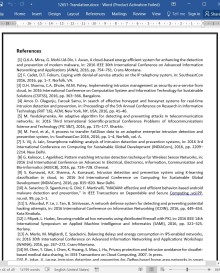
دانلود مقاله آینده زنجیره بلوکی برای امنیت اینترنت اشیا
چکیده
دستگاههای اینترنت اشیا بهطور فزایندهای در زمینههای غیرنظامی و نظامی، از شهرهای هوشمند و شبکههای هوشمند گرفته تا اینترنت پزشکی اشیا ، اینترنت رسانگرها ، اینترنت نظامی اشیا ، اینترنت میدان نبرد اشیا و غیره، دیده میشوند. در این مقاله به بررسی و مرور مقالاتی در زمینهی راهحلهای امنیتی IoT پرداختهایم که از ژانویهی سال 2016 به زبان انگلیسی چاپ شدهاند. از مشاهدات ما، عدم وجود مجموعهدادههای IoT با دسترسی عمومی، جهت استفاده در جوامع تحقیقاتی و شغلی است. با توجه به ماهیت حساس بالقوهی مجموعهدادههای IoT، نیاز به تدوین و توسعهی استاندارد اشتراکگذاری مجموعهدادههای IoT میان جوامع تحقیقاتی و شغلی و سایر ذینفعان احساس میشود. بنابراین، ابتدا به پتانسیل فنآوری زنجیرهی بلوکی در تسهیل امنیت اشتراکگذاری مجموعهدادههای IoT (مثلاً استفاده از زنجیرهی بلوکی برای اطمینان از یکپارچگی مجموعهدادههای به اشتراک گذاشته شده) و امن کردن سیستمهای IoT، قبل از ارائهی دو روش مفهومی مبتنی بر زنجیرهی بلوکی پرداختهایم. در انتهای این مقاله، 9 سوال تحقیقاتی بالقوه ارائه کردهایم.
1. مقدمه
فنآوریها شیوه و نحوهی زندگی ما را، بهویژه در جامعهی دادهمحور ما، تغییر دادهاند. دلیل بخشی از این امر، پیشرفت فنآوریهای نیمرسانا و ارتباطات است که باعث اتصال و ارتباط چندین دستگاه از طریق شبکه شده و راههای اتصال و ارتباط میان ماشینها و انسانها (برای مثال، ماشین به ماشین ) را فراهم میکنند. عموماً چنین روندی اینترنت همهچیز نامیده شده و شامل اینترنت اشیا، اینترنت پزشکی اشیا، اینترنت میدان نبرد اشیا، اینترنت رسانگرها و غیره است. با توجه به فراگیر بودن چنین دستگاههایی در جامعهی ما (برای مثال، در شهرهای هوشمند، شبکههای هوشمند و سامانههای سلامت هوشمند)، امنیت و حریم شخصی دو مورد از نگرانیهای اساسی این حوزه است. برای نمونه، در سال 2014 گزارش شد که بیش از 750000 دستگاه مصرفکننده در معرض توزیع فیشینگ و ایمیلهای اسپم بودند. در کاربردهای حساس به داده چون IoMT و IoBT، تضمین امنیت داده، سامانهها و دستگاهها، همراه با حفظ حریم شخصی داده و محاسبات داده حیاتی است. هرچند احتمال دارد تهدید یک سامانه ناشی از یک اقدام امنیتی باشد که به درستی بررسی نشده است. برای مثال، در یک محیط بیمارستانی نظامی یا غیرنظامی معمول، معمولاً گروه فناوری اطلاعات کنترل کل شبکه، شامل دستگاههای نقاط پایانی و دستگاههای IoMT (اصولاً هر وسیلهای با نشانی آیپی ) را برعهده دارند. انتظار آشنایی تیم IT با تمامی دستگاههای متصلشده، یک انتظار غیرواقعی است، هرچند آنها از قابلیت مدیریت سامانه برای نصب پچها ، دسترسی به دستگاهها و دادههای آنها از راه دور و غیره برخوردارند.
چه اتفاقی میافتد اگر در حین عمل جراحی، یکی از دستگاههای IoMT که داروها را مدیریت میکند یکباره خاموش شده و بعد از اعمال پچ از راه دور توسط مدیر سامانهی IT بازراهاندازی شود؟ احتمالاً این امر باعث هرج و مرج در اتاق عمل خواهد شد، چرا که گروه حراجی تصوری از آنچه که رخ داده، نخواهند داشت، نیازی به اشارهی تروما و عواقب احتمالی برای بیمار (مثلاً محروم شدن بیمار از اکسیژن منجر به آسیب مغزی و مرگ میشود) نیست. به بیان دیگر، عملیات بهظاهر معمول، مانند اعمال پچها و بازراهاندازی دستگاهها، میتوانند منجر به فاجعه شود.
در این مقاله به بررسی و مرور مقالاتی در زمینهی روشهای امنیتی طراحی شده برای IoT یا قابل استفاده در آن پرداختهایم که از ژانویهی سال 2016 به زبان انگلیسی چاپ شدهاند. بررسی روشهای حریم شخصی IoT را به مطالعات بعدی موکول میکنیم. مقالات انتخابی به دوستهی روشهای واکنشی و پیشکنشگری ، و روشهای واکنشی را به (1) سامانههای شناسایی نفوذ تنها و سامانههای پیشگیری از نفوذ و (2) روشهای امنیتی مبتنی بر همکاری طبقهبندی کردهایم.
5. آیندهای با زنجیرهی بلوکی؟
فنآوری IoT نقش مهمی در آیندهی قابل پیشبینی جامعهی ما، در هر دو زمینهی غیرنظامی و نظامی، شامل اینترنت پهپادها، اینترنت میدان نبرد اشیا و اینترنت نظامی اشیا، خواهد داشت. جای تعجب نیست که امنیت IoT به موضوع مورد علاقهی پژوهشگران تبدیل شده است.
در این مقاله به بررسی روشهای امنیتی طراحی شده برای IoT و سیستمهای مرتبط چاپ شده از سال 2016 را مرور کردیم. قابلیت شناسایی و پیشگیری از تهدیدهای موجود مهم است، اما توانایی پیشبینی تهدیدهای بالقوه و حملات در آیندهی نزدیک، کم اهمیتتر از این امر نیست. بنابراین، استدلال ما نیاز بیشتر به تحقیق و پژوهش در زمینهی امنیت پیشگویانهی IoT است – موضوع تحقیق 1. برای مثال، چگونه میتوان با اعتمادپذیری و کارآیی بالا، بردارهای تهدید بالقوهی IoT را شناسایی کرد و برای شکلگیری یک استراتژی کاهش بالقوه اطلاعرسانی کرد (مثلاً، برای هر تهدید شناسایی شده، یک سری عملیات قابل انجام تعریف شود). با توجه به ذات حساس به زمان برخی از کاربردهای IoT (در زمینههای نظامی یا دفاعی)، شناسایی بردارهای تهدید بالقوهی IoT و شکلگیری عملیات محتمل، باید خودکار و بدون دخالت انسانی انجام شود.
در این بررسی، متوجه عدم وجود مجموعهدادههای IoT با دسترسی عمومی و نبود مجموعهدادههای IoT نماینده شدیم که هر دو موضوع برای پژوهشهای امنیتی IoT ضروری است – موضوع تحقیق 2. بنابراین، نیازمند تدوین استانداردی برای مجموعهدادههای IoT هستیم که باعث تسهیل اشتراکگذاری مجموعهدادههای IoT برای مقاصد تحقیقاتی شود. همچنین بر پتانسیل زنجیرهی بلوکی جهت اشتراکگذاری و توزیع مجموعهدادهها در شبکهی تحقیقاتی تاکید کردیم.
Abstract
Internet of Things (IoT) devices are increasingly being found in civilian and military contexts, ranging from smart cities and smart grids to Internet-of-Medical-Things, Internet-of-Vehicles, Internet-of-Military-Things, Internet-of-Battlefield-Things, etc. In this paper, we survey articles presenting IoT security solutions published in English since January 2016. We make a number of observations, including the lack of publicly available IoT datasets that can be used by the research and practitioner communities. Given the potentially sensitive nature of IoT datasets, there is a need to develop a standard for sharing IoT datasets among the research and practitioner communities and other relevant stakeholders. Thus, we posit the potential for blockchain technology in facilitating secure sharing of IoT datasets (e.g., using blockchain to ensure the integrity of shared datasets) and securing IoT systems, before presenting two conceptual blockchain-based approaches. We then conclude this paper with nine potential research questions.
1. Introduction
Technologies have changed the way we live, particularly in our datadriven society. This is partly due to advances in semiconductor and communication technologies, which allow a multitude of devices to be connected over a network, providing us with ways to connect and communicate between machines and people (e.g., machine-to-machine). Such a trend is also commonly referred to as the Internet-of-Everything, comprising the Internet-of-Things (IoT), Internet-of-Medical-Things (IoMT), Internet-of-Battlefield-Things (IoBT), Internet-of-Vehicles (IoV), and so on. Given the pervasiveness of such devices in our society (e.g., in smart cities, smart grids and smart healthcare systems), security and privacy are two of several key concerns. For instance, it was reported in 2014 that more than 750,000 consumer devices were compromised to distribute phishing and spam emails [40]. In data-sensitive applications such as IoMT and IoBT, ensuring the security of the data, systems and the devices, as well as the privacy of the data and data computations, is crucial. However, a threat to a system can be the result of a security measure that is not well thought out. For example, in a typical civilian or military hospital setting, the Information Technology (IT) team generally has the control of the entire network, including endpoint devices and IoMT devices (basically, any devices with an IP address). It is not realistic to expect the IT team to be familiar with every individual connected device, although they have the system administrator capability to install patches, and access the device and their data remotely, and so on.
What happens if in the middle of a surgical operation, one of the IoMT devices administering drugs shuts down and reboots itself after a patch is applied remotely by the IT system administrator? This is likely to result in chaos in operating theaters, as the surgical team will not have any idea what happened not to mention, the trauma and potential consequences to the patient (e.g., depriving the patient of oxygen could result in brain damage and fatality). In other words, things can go wrong very quickly during seemingly routine operations, such as applying patches and the devices rebooting themselves.
In this paper, we survey articles on security techniques that are either designed for, or are applicable to IoT, published in English since January 2016. We defer a survey of IoT privacy techniques as future work. The located articles are then sorted into reactive and proactive approaches, we further categorize the reactive approaches into (1) Intrusion Detection Systems (IDS) only and Intrusion Prevention Systems (IPS), and (2) collaborative security approaches.
5. A blockchain future?
IoT technology will play an increasingly important role in our society for the foreseeable future, in both civilian and military (adversarial) contexts, including the Internet of Drones, Internet of Battlefield Things and Internet of Military Things. Not surprisingly, IoT security is a topic of ongoing research interest.
In this paper, we reviewed security techniques designed for IoT and related systems published since 2016. While it is important for us to be able to detect and prevent existing threats, the capability to predict potential threats and attacks in the near future is also, if not, more important. Hence, we argue that there is a pressing need for more extensive research in predictive IoT security – research topic 1. For example, how can we reliably and effectively identify potential IoT threat vectors to inform the formulation of a potential mitigation strategy (e.g., formulate a probable course of action for each identified threat). Owing to the timesensitive nature of certain IoT applications (e.g., in military or adversarial contexts), the identification of potential IoT threat vectors and the formulation of probable course(s) of action should be automated, with minimal human intervention.
We also observed the lack of publicly available IoT datasets and the absence of representative IoT datasets, both of which are important for IoT security research – research topic 2. Thus, we proposed the need for a standard to be established for IoT datasets that will facilitate the sharing of such datasets for research purposes. We also highlighted the potential of blockchain in sharing and distributing such datasets in a research network.
چکیده
1. مقدمه
2. بررسی و مرور IoT موجود و روشهای امنیتی مربوطه
2.1. روشهای شناسایی و پیشگیری از نفوذ
2.1.1. طبقهبندی بر اساس روشها
2.1.2. طبقهبندی بر اساس ساختار شبکه
2.1.3. طبقهبندی بر اساس کاربردها
2.1.4. خلاصه
2.2. روشهای امنیتی مبتنی بر همکاری
2.2.1. طبقهبندی بر اساس ساختارهای شبکه
2.2.2. طبقهبندی بر اساس کاربردها
2.3. روشهای امنیتی پیشگویانه
3. بحث و بررسی
4. زنجیرهی بلوکی برای IoT
4.1. زنجیرهی بلوکی در اشتراکگذاری مجموعهداده
4.2. شناسایی ثابتافزار و خودبهبودی مبتنی بر زنجیرهی بلوکی
5. آیندهای با زنجیرهی بلوکی؟
منابع
ABSTRACT
1. Introduction
2. Survey of existing IoT and related security approaches
2.1. Intrusion detection and prevention techniques
2.1.1. Classification by approaches
2.1.2. Classification by network structure
2.1.3. Classification by applications
2.1.4. Summary
2.2. Collaborative security techniques
2.2.1. Classification by network structures
2.2.2. Classification by applications
2.3. Predictive security techniques
3. Discussion
4. Blockchain for IoT
4.1. Blockchain in dataset sharing
4.2. Blockchain-based compromised firmware detection and self-healing
5. A blockchain future?
References
- اصل مقاله انگلیسی با فرمت ورد (word) با قابلیت ویرایش
- ترجمه فارسی مقاله با فرمت ورد (word) با قابلیت ویرایش، بدون آرم سایت ای ترجمه
- ترجمه فارسی مقاله با فرمت pdf، بدون آرم سایت ای ترجمه



